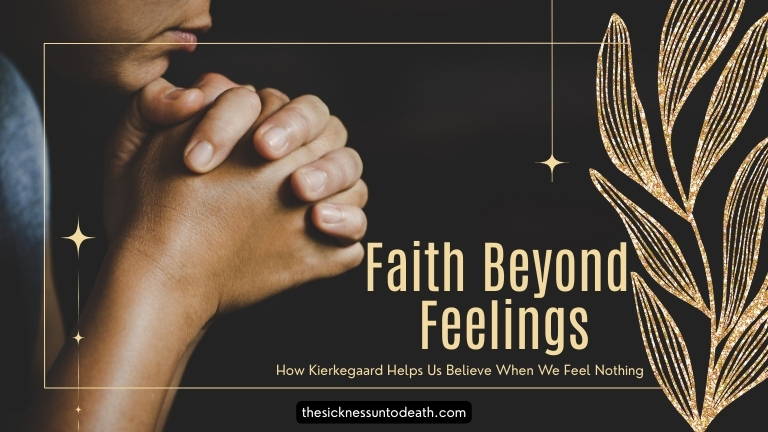Reflect on how Kierkegaard’s view of faith challenges emotional dependence, guiding readers toward deeper spiritual maturity.
Sometimes we feel close to God.
Other times? Nothing.
No sense of peace. No spark of joy. No stirring of the heart. Just… silence.
If you’ve ever wondered, “What’s wrong with me?” when your prayers feel flat or your faith feels cold—you’re not alone. And you’re not broken.
Søren Kierkegaard, the Danish philosopher and theologian, wrote for people exactly like you—those wrestling with the tension between belief and emptiness. He knew what it was to feel spiritually distant, and yet, he still called that space sacred.
Why? Because faith, for Kierkegaard, isn’t about what you feel. It’s about what you choose.
When the Feelings Fade
In a world that glorifies emotional experience—where even spirituality is expected to “feel good”—Kierkegaard offers a very different path.
He argues that real faith begins not in our feelings, but in our will. It’s not a mood. It’s a movement. A decision to trust, even when everything in you wants to give up.
“Faith is the highest passion in a human being.”
But passion doesn’t always mean enthusiasm. Sometimes, it means persistence. Staying when you don’t feel it. Choosing what’s true over what’s easy.
Belief Without the Buzz
We often chase spiritual highs—moments of clarity, connection, or comfort. And those moments are beautiful.
But Kierkegaard warns against becoming dependent on emotion. Because what happens when those feelings disappear? Does faith go with them?
Not if it’s rooted deeper.
To Kierkegaard, mature faith is what remains when the feelings don’t. It’s the slow, quiet, faithful decision to keep going. Not because we’re moved—but because we’ve committed.
Faith That’s Honest
Kierkegaard doesn’t ask us to fake it. He doesn’t dismiss our dryness, or minimise how painful it is when God feels distant. In fact, he leans into it.
He writes about the silence of God, the ache of despair, and the difficulty of belief. But he also insists that it’s in those very moments—when we feel nothing—that something sacred can begin.
Because faith isn’t the absence of struggle. It’s the act of showing up anyway.
Choosing Faith in the Quiet
So what does faith look like when you feel empty?
- It looks like still praying, even when the words feel hollow.
- It looks like holding on, not out of emotion, but out of hope.
- It looks like staying open, even when you’re tired.
And it looks like trusting that God is near, even when your heart says otherwise.
Final Thoughts: A Deeper Kind of Belief
If you’re walking through a season of spiritual numbness, you’re not doing it wrong. You’re growing roots. You’re building a faith that isn’t swayed by feelings—but anchored in something far deeper.
Kierkegaard reminds us that true faith is not dependent on emotional highs. It’s shaped in the quiet. It’s chosen in the dark. And it often shows its strength not when belief is easy—but when it’s hard.
Go Deeper
📖 Visit www.thesicknessuntodeath.com
Explore a modern translation of Kierkegaard’s The Sickness Unto Death—a profound reflection on despair, faith, and what it means to be a self in the face of silence.
Whether you feel everything or nothing right now, this work offers a quiet companion for the honest, faithful journey forward.

